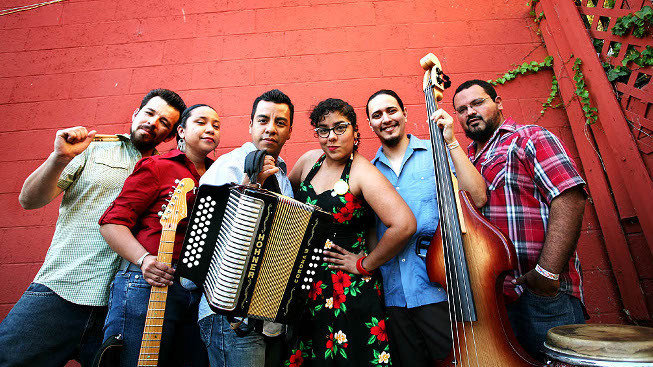Say hello to La Santa Cecilia, from Los Angeles but with roots in Mexico and elsewhere in Latin America. The band is named after the patron saint of music and as band members prepare to mark their 10th anniversary this November, it’s hard to think of another Latin-American group from anywhere that has covered The Beatles and U2 next to Lhasa de Sela and Latin standards like Besame Mucho, making all of it their own.
“We always joke that our stage show goes from dancing to yelling to screaming to crying,” said guitar and accordion player Pepe Carlos. “It’s a little bit of everything, about connecting with the crowd. As long as we make them feel something, it doesn’t really matter if it’s an original or not. That’s how the music has been able to bridge all these cultures.”
The band made its reputation by using a range of unexpected covers to fill out their sets and three early EP releases before they won a Latin Grammy Award for their debut full-length recording on Universal Music, 2013’s Treinta Dias, the album that launched their international profile. These days about 75 per cent of their concert material is original songs, but either way they often sing bilingual versions with verses in Spanish and English.
Some of their covers have taken on a whole new spin. Imagine U2’s One as a Tex-Mex tune, or consider the Lennon/McCartney classic Strawberry Fields Forever with a Latin treatment.
“We always try to give it our own flavour. Strawberry Fields came early on when we didn’t have enough originals, but it’s taken on a different meaning. To us it means being grateful for all the field workers who bring food to your table, people cultivating the strawberry fields here in California or elsewhere. We throw some bossa nova, some bolero, cumbia and ranchero, about five different rhythms in, and people love it.”
Some of their original songs also comment on the realities of their community and the need for social change. You might wonder if the band has ever dedicated a tune to President Donald Trump.
“No, I don’t think he deserves our time. It’s so unfortunate to see someone in government who has divided the country so much. Whether we’re touring in Mexico or the U.S. you see that people love each other and it’s great to see people connect with the band. We’re Mexicans or Latinos but we love American music as well. It’s unfortunate that leaders are some of the people spreading hate.”
La Santa Cecilia’s recent seventh release, Amar Y Vivir (Love And Live), was a special project, an amazing audio-visual album recorded live-to-tape in different venues, parks and streets all over Mexico City with videos to match each song. Most all the tracks are covers again, this time of traditional Latin American or modern Mexican classics, but the live circumstances hearken back to the group’s beginnings when they played neighbourhood parties, cafes and other small venues just to get heard. Guest cameos from a few of their Latin American musical friends are included.
“It was important for us to do this album and a good time to do it with nearly 10 years behind us. To see ourselves in the future, we had to go back to our roots, and we were happy to re-imagine some of these songs so they won’t get lost in time.”
Like the rest of the band, Pepe Carlos came to Los Angeles as a youngster, in his case at five. He was an undocumented immigrant for 27 years before he got his legal resident status. Of the four original founding members (now in their 30s), Carlos, percussionist Miguel Ramirez and vocalist Marisol Hernandez were all born in Mexico. Bassist Alex Bendana was born in Venezuela and raised briefly in Nicaragua before being brought to L.A. at one year old. Electric guitarist Marco Sandoval and drummer Andres Torres complete the touring group.
They had all been exposed to a breadth of Latin American styles at home, from boleros to norteno to Afro-Cuban, cumbia and mariachi, but they couldn’t help but absorb popular currents of American music. Now everyone contribute ideas to the writing of original songs or arrangements.
“When we started we didn’t focus on any genre, like rock or whatever. We wanted to experiment and I think part of it was from living here in Los Angeles where you have so many cultures coming together. In some songs in the early days you would find four different rhythms. Through the years we’ve found a process to structure songs better. We’ve evolved into a multicultural act as we see it.”
La Santa Cecilia performs throughout the Americas today, toured Mexico five times last year, and made its Canadian debut in Toronto and Vancouver this summer. They hope to take their sounds to Europe and Asia next.





